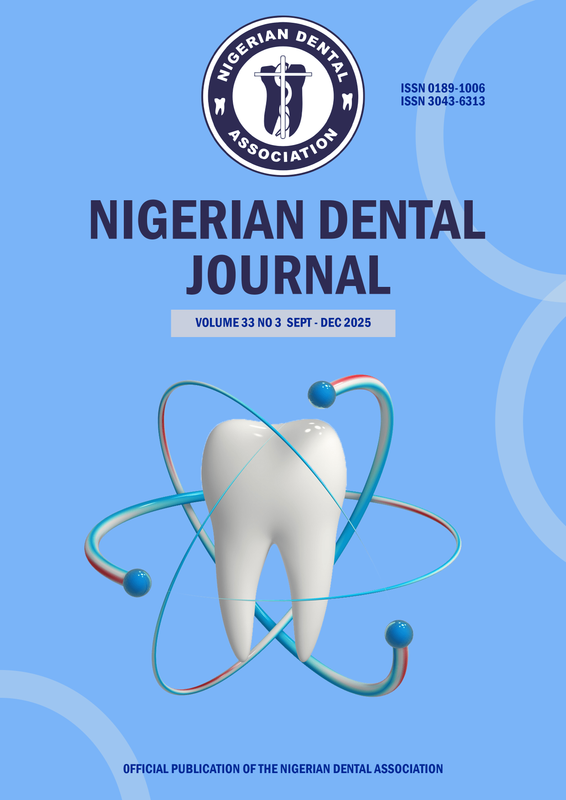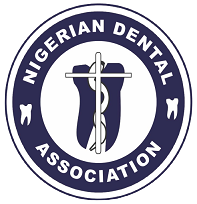AMELOBLASTOMA WITH INFRATEMPORAL EXTENSION: A REVIEW OF LITERATURE
DOI:
https://doi.org/10.61172/ndj.v30i2.102Keywords:
Ameloblatoma, temporal extension, infratemporal extension, recurrent ameloblastomaAbstract
Ameloblastomas are benign tumors of odontogenic epithelium. They are locally aggressive with tendency to recur and sometimes with metastatic behavior. Recurrences often occur due to incomplete treatment and they can occur at difficult sites such as temporal and infratemporal fossa. Recurrences in the temporal area are very rare and are related to the type of primary treatment.
AIM: This literature review aims to answer the question on how common recurrent ameloblastoma entends to the infratemporal fossa and how this is related to the site of the primary lesion.
METHODS; Web search for case reports, case series of ameloblatoma with temporal, infratemporal extension, published in the English literature was carried out. Search results were further scrutinized for age, sex, location of lesion, histology, treatment modalities and recurrence following the adopted treatment modalities and treatment outcome.
RESULT; A total 15 full length articles were included in this study. Twelve were case reports and 3 were case series. Of 28 patients with ameloblastoma in the articles, only 22 were recorded to have presented with ameloblastoma with infratemporal or temporal fossa involvement. All the cases of ameloblastoma involving the infratemporal/temporal fossa were recurrent tumors and the average time from first surgical intervention to recurrence was 11.36 years. Most of the primary cases were seen in the mandible (73%) with body/ramus region being the commonest location. Only 5cases were reported to be primarily maxillary ameloblastoma.
CONCLUSION; This review has shown that temporal/infratemporal extension of ameloblastoma occurs commonly with recurrent lesions, although the overall reported incidence is relatively low. Aggressive primary tumor resection, especially for extensive mandibular lesions may be key to preventing this tumor extension.
Downloads
References
Olaitan AA, Adeola DS, Adekeye EO. Ameloblastoma: clinical features and management of 315 cases from Kaduna, Nigeria. J Cranio-Maxillofacial Surg. 1993;21(8):351-355. doi:10.1016/S1010-5182(05)80497-4
Ladeinde AL, Ogunlewe MO, Bamgbose BO, Adeyemo WL, Akinwande JA. Ameloblastoma : Analysis of 207 cases in a Nigerian teaching hospital. Quintessence Int. 2006;37(1):69-74.
Nastri AL, Wiesenfeld D, Radden BG, Eveson J, Scully C. Maxillary ameloblastoma: a retrospective study of 13 cases. Br J Oral Maxillofac Surg. 1995;33(1):28-32. doi:10.1016/0266-4356(95)90082-9
Vaishampayan SS, Nair D, Patil A, Chaturvedi P. Recurrent ameloblastoma in temporal fossa : A diagnostic dilemma. Contemp Clin Dent. 2013;4(2):220-222. doi:10.4103/0976-237X.114852
Kyriazis AP, Karkazis GC, Kyriazis AA. Maxillary ameloblastoma with intracerebral extension. Report of a case. Oral Surgery, Oral Med Oral Pathol. 1971;32(4):582-587. doi:10.1016/0030-4220(71)90323-9
Komisar A. Plexiform Ameloblastoma of the Maxilla with Extension to the Skull Base. Head Neck Surg. 1984;7:172-175.
Oka K, Fukui M, Yamashita M, et al. Mandibular ameloblastoma with intracranial extension and distant metastasis. Clin Neurol Neurosurg. 1986;88(4):303-309.
Daramola J, Abioye A, Ajagbe H, Aghadiuno P. Maxillary malignant ameloblastoma with intraorbital extension: report of case. J Oral Surg (Chic). 1980;38:203–6.
Reichart PA, Philipsen HP, Sonner S. Ameloblastoma: Biological profile of 3677 cases. Eur J Cancer Part B Oral Oncol. 1995;31(2):86-99. doi:10.1016/0964-1955(94)00037-5
Luo Q, Diao W, Luo L, Zhang Y. Comparisons of the Computed Tomographic Scan and Panoramic Radiography Before Mandibular Third Molar Extraction Surgery. Med Sci Monit. 2018;24:3340-3347. doi:10.12659/MSM.907913
Zwahlen RA, Gratz KW. Maxillary ameloblastomas : a review of the literature and of a 15-year database. J Cranio-Maxillofacial Surg. 2002;20:273-279. doi:10.1054/jcms.2002.0317
Rauso R, Tartaro G, Gherardini G, Puglia F, Santagata M, Colella G. Recurrence of ameloblastoma in temporal area: primary treatment influences recurrence rate. Journal of Craniofacial Surgery. 2010;21(3):887-891. doi:10.1097/SCS.0b013e3181d80a1a = ruso
Maia EC, Sandrini FAL. Management techniques of ameloblastoma: a literature review. RGO - Rev Gaúcha Odontol. 2017;65(1):62-69. doi:10.1590/1981-863720170001000093070
Adeyemo WL, Bamgbose BO, Ladeinde AL, Ogunlewe MO. Surgical management of ameloblastomas: Conservative or radical approach? A critical reviewof the literature. Oral Surg. 2008;1(1):22-27. doi:10.1111/j.1752-248X.2007.00007.x
Carlson ER, Marx RE. The ameloblastoma: Primary, curative surgical management. J Oral Maxillofac Surg. 2006;64(3):484-494. doi:10.1016/j.joms.2005.11.032
Auluck A, Shetty S, Desai R, Mupparapu M. Recurrent ameloblastoma of the infratemporal fossa : diagnostic implications and a review of the literature. Dentomaxillofacial Radiol. 2007;36:416-419. doi:10.1259/dmfr/45988074
Al-Bayaty HF, Murti PR, Thomson ERE, Niamat J. Soft tissue recurrence of a mandibular ameloblastoma causing facial deformity in the temporal region: Case report. J Oral Maxillofac Surg. 2002;60(2):204-207. doi:10.1053/joms.2002.29826
To EWH, Tsang WM, Pang PCW. Recurrent ameloblastoma presenting in the temporal fossa. Am J Otolaryngol. 2002;23(2):105-107. doi:10.1053/ajot.2002.30629
Todd R, Gallagher GT, Kaban LB. Mass in the infratemporal fossa. In: Oral Surgery, Oral Medicine, Oral Pathology, Oral Radiology, and Endodontics. Vol 84. Mosby Inc.; 1997:116-118. doi:10.1016/S1079-2104(97)90054-8
Weiss JS, Bressler SB, Jacobs EF, Shapiro J, Weber A, Albert DM. Maxillary Ameloblastoma with Orbital Invasion: A Clinicopathologic Study. Ophthalmology. 1985;92(5):710-713.
Faras F, Abo-Alhassan F, Israël Y, Hersant B, Meningaud JP. Multi-recurrent invasive ameloblastoma: A surgical challenge. International Journal of Surgery Case Reports. 2017;30:43-45.
Sharma S, Kumar D, Vashistha A, Bihani U, Trehan M. Recurrent unicystic ameloblastoma of the infratemporal and temporal fossa. International Journal of Clinical Pediatric Dentistry. 2009;2(1):33.
Ferretti C, Polakow R, Coleman H, Dent M. Recurrent ameloblastoma: Report of 2 cases. J Oral Maxillofac Surg. 2000;58(7):800-804. doi:10.1053/joms.2000.7271
Scaccia FJ, Strauss M, Arnold J, Maniglia AJ. Maxillary ameloblastoma: case report. American Journal of Otolaryngology. 1991;12(1):20-25.
Luc JM, Mommaerts MY, Fossion E, Bossuyt M. Late loco-regional recurrences after radical resection for mandibular ameloblastoma. International journal of oral and maxillofacial surgery. 1988;17(5):310-315.
Aramanadka C, Kamath AT, Kudva A. Recurrent ameloblastoma: a surgical challenge. Case Reports in Dentistry. 2018;2018:1-7
Phillips SD, Corio RL, Brem H, Mattox D. Ameloblastoma of the mandible with intracranial metastasis: A case study. Archives of Otolaryngology–Head & Neck Surgery. 1992;118(8):861-863.
Pogrel MA, Montes D. Is there a role for enucleation in the management of ameloblastoma? Int J Oral Maxillofac Surg. 2009;38(8):807-812.
Miloro M. Microneurosurgery. In: Miloro M, Ghali GE, Larsen PE, Waite P, eds. Peterson’s Principles of Oral and Maxillofacial Surgery . 2nd ed. BC Decker; 2004:819-827.
Mbarki I, Randriamarosona N, Touim SH, et al. Radiotherapy for large recurrent ameloblastoma of the mandible previously treated by surgery: A case report. Int J Clin Case Reports Rev. 2021;6(2):01-05. doi:10.31579/2690-4861/089
Gardner DG. Radiotherapy in the treatment of ameloblastoma. Int J Oral Maxillofac Surg. 1988;17(3):201-205. doi:10.1016/S0901-5027(88)80033-X
Yoshida K, Kawase T, Tomita T, et al. Surgical Strategy for Tumors Located in or Extending From the Intracranial Space to the Infratemporal Fossa — Advantages of the Transcranial Approach ( Zygomatic Infratemporal Fossa Approach ) and the Indications for a Combined Transcranial and Transcervi. Neurol Med Chir. 2009;49:580-586.
Downloads
Published
Issue
Section
License
Copyright (c) 2023 Aliyu Ope Oyeneyin , Adegbayi Adekunle

This work is licensed under a Creative Commons Attribution 4.0 International License.
Open Access Statement
- We became fully Open Access since January 2023.
- Our new and archived materials are available free of charge on open basis and under a Creative Commons license as stated below.
Copyright statement
Copyright © 1999 The authors. This work, Nigerian Dental Journal by Nigerian Dental Association is licensed under Creative Commons Attribution 4.0 International License.


